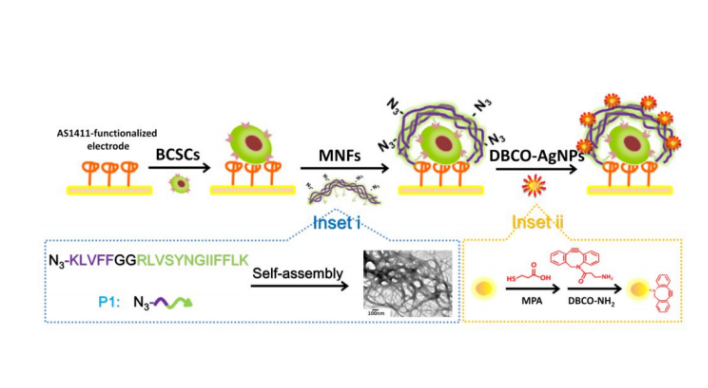文献:
Self-assembling peptide-based multifunctional nanofibers for electrochemical identification of breast cancer stem-like cells
文献链接:
https://pubs.acs.org/doi/10.1021/acs.analchem.8b05359
作者:
Yingying Tang, Yuhao Dai, Xiang Huang, Lingling Li, Bing Han, Ya Cao, and Jing Zhao
相关产品:
原文摘要:
Cancer stem-like cells are closely related with the development and metastasis of tumors. Herein, an electrochemical method is proposed to identify stem-like cells in breast tumor. The core concept of the method is the use of multifunctional nanofibers (MNFs) which are synthesized through facile self-assembly of peptide probes. MNFs can perform three functions: specifically targeting surface biomarker to identify stem-like cells, recruiting silver nanoparticles (AgNPs) to generate electrochemical signals and providing large amounts of reaction sites to amplify signals. Specially, breast cancer stem cells (BCSCs) are first captured by nucleolin aptamer immobilized on the electrode surface and then selectively recognized by MNFs through the binding with CD44, thereby offering a large number of azide group for signal labeling. By tracing electrochemical signals from MNFs-recruited AgNPs, the method demonstrates to detect target cells as low as 6 cells/mL within a wide linear range from 10 to 5×105 cells/mL. Moreover, the method can not only recognize BCSCs with high selectivity in complex environment, but also monitor drug-induced stemness changes with high sensitivity, providing promising prospective clinic applications in the future.
该文献的核心概念是使用多功能纳米纤维(MNF),这些纤维是通过肽探针的简单自组装合成的。MNF可以执行三个功能:特异性靶向表面生物标志物以识别干细胞样细胞,招募银纳米粒子(AgNP)产生电化学信号,并提供大量反应位点来放大信号。客户使用利用DBCO具有高度反应活性,特别擅长与含有叠氮化物基团的化合物发生环加成反应,这种反应被称为“DBCo点击反应”。这种反应具有快速、无催化剂且生物相容性良好的特点制备了DBCO功能化银纳米粒子DBCOAgNPs,具体步骤如下:

图为:DBCOAgNPs制备原理
将硼氢化钠滴加入硝酸银柠檬酸三钠的混合物中,剧烈搅拌。当溶液的颜色逐渐变成黄色时,将得到的溶液在黑暗中保存过夜。对于功能修饰,将MPA加入AgNPs中,在4°C下放置,通过银硫作用将羧基附着在AgNPs表面。然后,加入DBCO-NH2,通过羧基和氨基的相互作用得到DBCOAgNPs。
结论:MNFs的长纤维束形态,证实了P1具有良好的自组装性能。然后,通过阳性圆二色性(CD)信号和218 nm左右的阳性(CD)信号证实MNFs的β片结构(图B)。如下图显示了与MNFs孵育后BCSCs的荧光图像。显然,通过使用DBCO-Cy5作为荧光染料,纤维网络环绕一个大面积BCSCs相当强烈的红色荧光,不仅确认叠氮化物组的存在MNFs表面也展示良好的性能mnfBCSCs识别和信号标记。然而,一旦MNFs与cd44阴性对照细胞(如BT-474细胞)孵育,在DBCO-Cy5存在的情况下,几乎没有观察到荧光信号,进一步证明了MNFs选择性识别的能力。

图为:(A)与MNFs孵育后的BCSCs和对照细胞(以BT-474细胞为模型)的荧光显微镜图像。(B)的扫描电镜图像

 2024-11-18 作者:wff 来源:
2024-11-18 作者:wff 来源:

